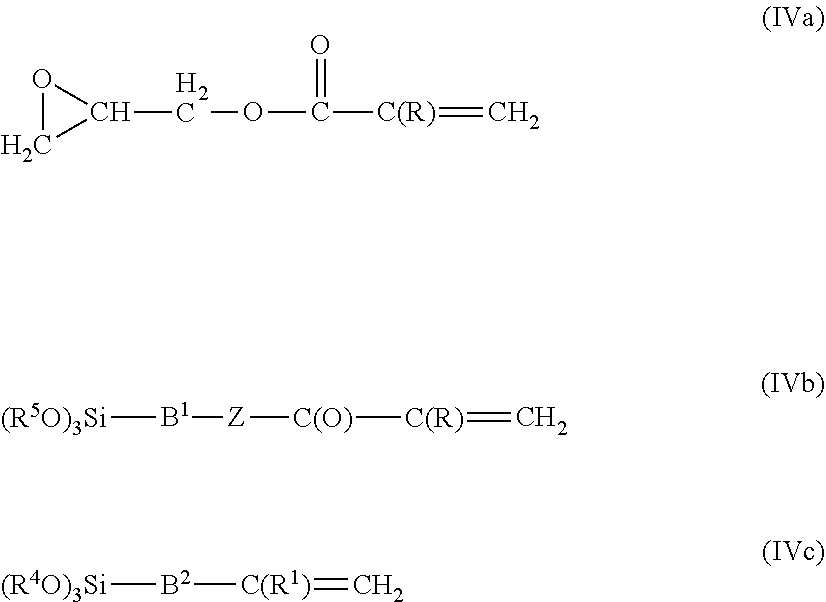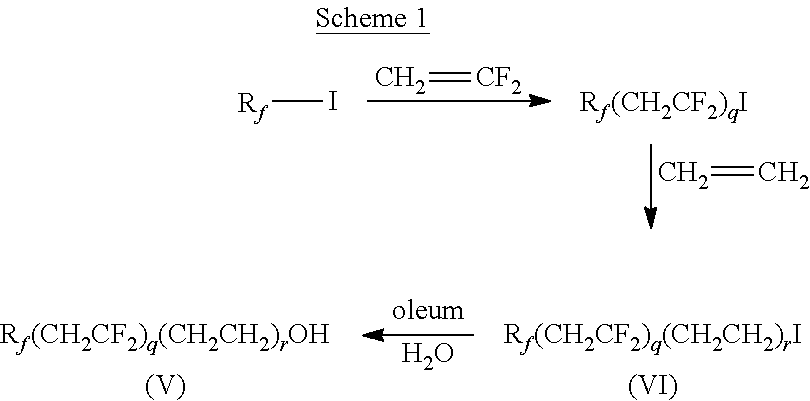Fluoropolymer compositions and method of use
a technology of fluoropolymer and composition, which is applied in the field of compositions comprising fluorinated copolymers, can solve the problems of inability to prepare polymers, inability to commercialize short-chain perfluoroalkyls, and inability to demonstrate useful properties
- Summary
- Abstract
- Description
- Claims
- Application Information
AI Technical Summary
Benefits of technology
Problems solved by technology
Method used
Image
Examples
example 1-8
[0126]Examples 1-8 were prepared using the various fluorinated monomers listed in Table 5. A constant weight of various fluorinated monomers was used in Examples 1-8 to provide polymer emulsions. The compositions of the emulsions are listed in Tables 6 and 7
TABLE 5Fluorinated Monomers for Examples 1-8ExampleFluorinated Monomer1A6-acrylate2A7-acrylate3A11-acrylate4A12-acrylate5A6-methacrylate6A7-methacrylate7A11-methacrylate8A12-methacrylate
TABLE 6Emulsion Composition for Examples 1-4MaterialEmulsion, gfluorinated monomer11.25per Table 52-ethylhexyl acrylate3.75N-methylol acrylamide0.32-hydroxyethyl0.15methacrylateacetic acid0.45ARMEEN DM 18D0.75goctadecylamineDeionized water35
TABLE 7Emulsion Composition for Examples 5-8MaterialEmulsion, gfluorinated monomer11.25per Table 52-ethylhexyl methacrylate3.75N-methyl acrylamide0.32-hydroxyethyl0.15methacrylateacetic acid0.45ARMEEN DM 18D0.75goctadecylaminedeionized water35
[0127]Each emulsion composition was sonicated for about 3 min to prov...
example 9
[0133]Sodium chloride (0.025 g), isopropyl alcohol (11.24 g), 2-(N,N-diethylamino)ethyl methacrylate (1.76 g), glycidyl methacrylate (0.29 g), A11-acrylate (8.20 g) and dodecyl mercaptan (0.02 g) were charged in a 250 mL flask, which was equipped with a condenser and stirrer. A solution of VAZO 67 (0.033 g) in isopropyl alcohol (2.5 g) was added dropwise to the flask. The mixture was stirred and purged with nitrogen for 1 h at 28° C. The temperature was then raised to 68° C. for 16 hours. The mixture was then cooled to 65° C. A mixture of acetic acid (0.6 g) and water (100 g) was added, converting the polymer to be a homogenous dispersion. During the dispersion stage, the acetic / water mixture was maintained at about 65° C. with agitation. The isopropyl alcohol was then removed by distillation to provide a polymer dispersion (13.91% solids).
Oil Repellency for Paper
[0134]A bath was prepared containing about 4 parts by weight of starch (Penford GUM 280 corn starch) and about 94 parts b...
example 10
[0135]VAZO 67 (0.047 g) dissolved in MIBK (0.47 g) was added to the mixture of 2-(N,N-diethylamino)ethyl methacrylate (3.2 g), A11-methacylate (6.25 g), and MIBK (7.69 g) at 35° C., and the mixture heated at 70° C. over night. Water (19 g) and acetic acid (1.37 g) were added and the mixture was stirred at 70° C. for 0.5 hours. The MIBK was removed under reduced pressure to provide a polymer dispersion (30.88% solids). The dispersion was tested on stone and tile substrates for repellency and stain resistance.
[0136]A treating solution was prepared by adding the dispersion of Example 10 (1.01 g) to 14.0 g of deionized water to provide a 0.8% F dispersion. The 0.8% F dispersion was applied at about 0.40 g per substrate, or about 100 g / m2, in treating limestone; and 0.44 g per substrate in treating granite substrates; according to Test Methods 3 and 4, defined above. The controls were untreated substrates. The results are listed in Tables 12 and 13. As discussed in Test Method 4, a lower...
PUM
| Property | Measurement | Unit |
|---|---|---|
| stain resistance | aaaaa | aaaaa |
| weight | aaaaa | aaaaa |
| covalent | aaaaa | aaaaa |
Abstract
Description
Claims
Application Information
 Login to View More
Login to View More - R&D
- Intellectual Property
- Life Sciences
- Materials
- Tech Scout
- Unparalleled Data Quality
- Higher Quality Content
- 60% Fewer Hallucinations
Browse by: Latest US Patents, China's latest patents, Technical Efficacy Thesaurus, Application Domain, Technology Topic, Popular Technical Reports.
© 2025 PatSnap. All rights reserved.Legal|Privacy policy|Modern Slavery Act Transparency Statement|Sitemap|About US| Contact US: help@patsnap.com



